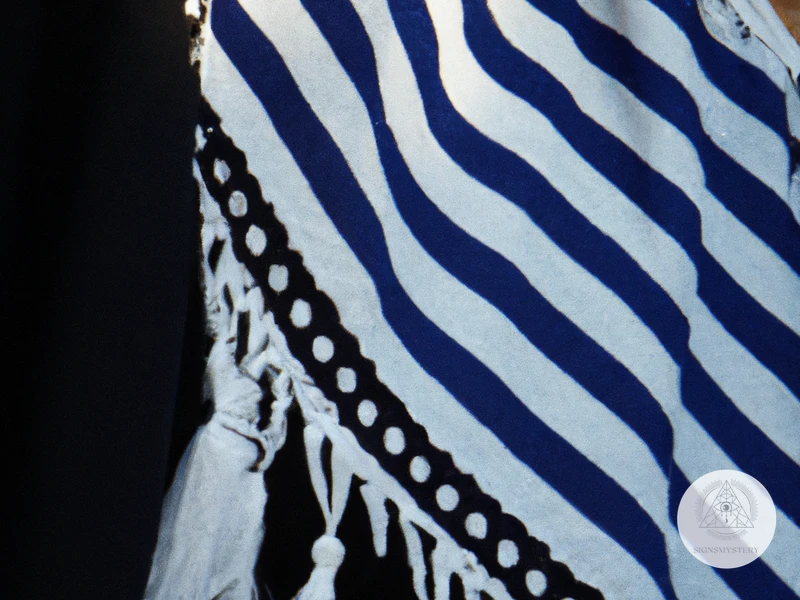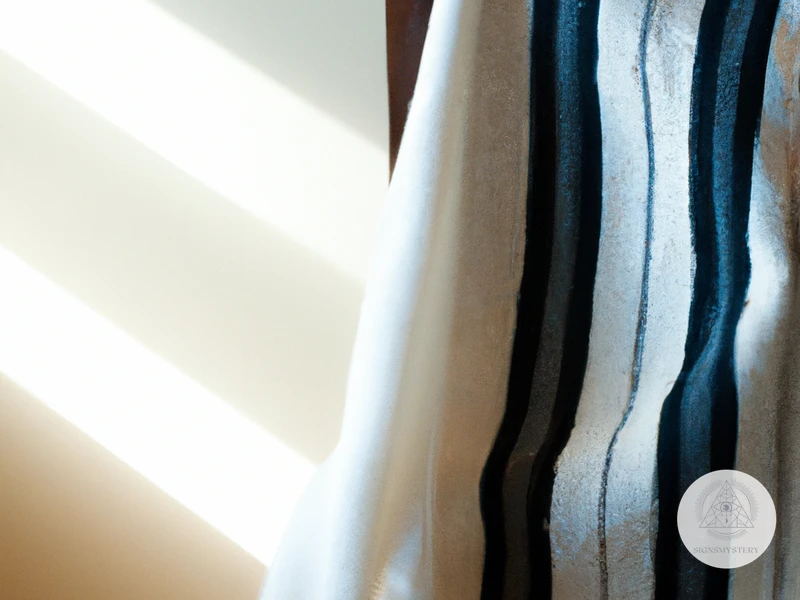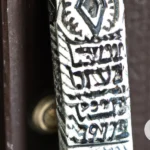The Tallit, also known as the Jewish prayer shawl, is a garment steeped in tradition and rich in symbolism. For centuries, it has been an integral part of Jewish worship and is considered a sacred item. However, the history, types, and significance of the Tallit are often unknown to many. In this article, we will delve deep into what the Tallit is, its history, symbolism, types, and how to properly wear it. Join us on a journey through this beautiful and meaningful prayer shawl.
What is a Tallit?

A Tallit is a Jewish prayer shawl traditionally worn during morning prayers, on the Sabbath, and on holidays. The garment is usually made of wool or silk and features four corners with fringes called tzitzit. These fringes serve as a reminder of the commandments and the wearer’s connection to God. The Tallit is an essential accessory for Jewish worship, and it has become a symbol of Jewish identity and tradition. Different variations of the Tallit can be seen in synagogues around the world, and it is often adorned with Jewish symbols such as the Menorah, the Star of David, and Hebrew letters.
The History of the Tallit
The Tallit, also known as the prayer shawl, has a long history in Jewish tradition. It originated from the biblical commandment to wear fringes (tzitzit) on the corners of garments as a reminder of God’s commandments.
The use of the Tallit in prayer can be traced back to the time of the Second Temple in Jerusalem. The Jewish sages of that time believed that wearing the Tallit during prayer enhanced the spiritual experience, and it became a widely accepted custom.
During the Middle Ages, the Tallit became more unique in its design and was decorated with colorful stripes and intricate patterns. The wool material was also improved and came to be made in a variety of colors.
In modern times, the Tallit continues to undergo changes. Some modern Tallitot are made of synthetic materials and have new designs. Some even incorporate special technologies, such as antimicrobial fabrics for hygiene and water-wicking for comfort.
Despite these changes, the Tallit remains an important symbol of Jewish identity and is often decorated with Jewish symbols such as the Star of David, the Menorah and Hebrew letters.
Symbol: Star of David, Menorah, Hebrew letters
Interesting fact: The Tallit is sometimes referred to as “the tent of God” because of its rectangular shape and the idea that it is like a personal sanctuary during prayer.
The Different Types of Tallit
Tallitot come in a variety of styles and materials, each with their unique significance and beauty. The most common types of Tallitot are the traditional wool Tallit, the light and airy cotton Tallit, and the modern silk Tallit.
The wool Tallit, also known as the prayer shawl, is made of thick, warm wool and is traditionally worn during morning prayers. The wool Tallit is perfect for cold weather, as it provides warmth and comfort. It is also available in different sizes, from small to extra-large, to accommodate various body sizes and preferences.
The cotton Tallit, on the other hand, is a lighter and cooler option and is typically worn during the summer months or in warmer climates. It is an excellent choice for those who find wool to be too scratchy or heavy. Cotton Tallit also comes in various colors and designs, making it a popular choice for younger worshippers.
Silk Tallitot are a popular modern option for those seeking a more luxurious and stylish prayer shawl. They come in a variety of colors, patterns, and designs, from classic black and white stripes to vibrant and elaborate illustrations. Silk Tallitot are often adorned with intricate embroidery and can be purchased with matching bags and kippot.
Regardless of the material or design, all Tallitot have one thing in common: they are a significant symbol of the Jewish faith and are worn with deep reverence and respect. Some Tallitot even have additional symbols and designs on them, such as the Star of David or Hebrew letters, to further express Jewish identity and pride.
In addition to the three main types of Tallitot mentioned above, there are also variations such as the Tallit katan, which is a small prayer shawl worn under clothing, and the Tallit gadol, which is a large prayer shawl used during synagogue services. No matter the type or purpose of the Tallit, it serves as a powerful reminder of the commandments of God and the importance of prayer in the Jewish faith.
If you want to learn more about other Jewish symbols, you can find additional information about the Star of David, Menorah, Hamsa, Mezuzah, Torah Scroll, Kippah, and Hebrew letters on different articles.
The Symbolism of the Tallit
The Tallit is an essential Judaic garment with deep symbolism. The garment is a rectangular shawl made of wool, cotton, or silk, with fringes tied at the four corners called Tzitzit. The Tallit also features a blue thread called Tekhelet, which symbolizes the sea and the sky and connects the wearer with God’s heavenly presence. It also has stripes of white and black or blue, representing the unique pattern of the entire Jewish people. The Tallit is a reminder of God’s commandments, with the four corners andTzitzit representing the 613 commandments. The Tallit connects the wearer with the divine and unites Jews worldwide with Jewish identity and beliefs. Other Jewish symbols include the Star of David, Menorah, Hamsa, Mezuzah, Torah Scroll, and Hebrew Letters, with a Kippah also a symbol of Jewish culture.
The Four Corners and Tzitzit
The Tallit, or Jewish prayer shawl, is characterized by its four corners, each adorned with tzitzit. These tzitzit, or tassels, are a fundamental part of Jewish tradition and symbolize a connection between Jews and their faith. Each tzitzit consists of four strands, and according to tradition, a total of 613 knots and 1,613 strings were originally used to make them.
The purpose of tzitzit is to constantly remind Jews of their relationship with God and their obligation to follow his commandments. It is believed that the combination of the number of strands and knots used in each tzitzit corresponds to various aspects of Jewish tradition and the commandments given to the Jewish people through Moses.
During prayer, the custom is to hold the tzitzit and recite a blessing, which acknowledges the importance of the tzitzit and their significance in Jewish tradition. This blessing is known as the “winding of the tzitzit” and is an integral part of wearing a Tallit.
The four corners and tzitzit of the Tallit represent a deep connection between Jews and their faith, their history, and the commandments that guide their lives. It serves as a personal reminder of their connection to God and an outward symbol of their faith to the rest of the world.
The Blue Thread and Tekhelet
The color blue has a very important symbolism in Judaism, and specifically in the context of the Tallit. According to Jewish tradition, the blue thread that appears on the Tallit is a reminder of the tekhelet, a special blue dye that was once used in the weaving of the Tallit. The exact source of the tekhelet dye is not fully known, but it is believed to have been derived from a specific type of sea creature called the chilazon. The dyeing process was so complex and time-consuming that it was reserved only for the wealthiest members of society, and the wearing of the blue Tallit was seen as a status symbol.
The significance of the blue thread and tekhelet goes even deeper than that, however. In Jewish mysticism, the blue color represents the sefirah of chesed, which means “loving-kindness”. This concept refers to the idea that God’s love is constantly flowing into the world, and it is up to us to receive it and reflect it back into the world through acts of kindness and compassion. It is believed that the wearing of the blue Tallit with its tzitzit serves as a reminder of this flow of divine love, and encourages the wearer to live their life in service to others.
Despite the deep significance of the blue thread and tekhelet, the tradition of using this dye was lost to the Jewish people for many centuries. It was only in recent years that a group of scholars and artisans were able to rediscover the process of making the tekhelet dye, using a type of mollusk found in the waters near Israel. Today, there are a small number of Jewish people who choose to wear a Tallit with the tekhelet dye, as a way of reconnecting to this ancient tradition and the deeper spiritual meaning that it represents.
How to Wear a Tallit
Wearing a Tallit is a sacred practice in the Jewish tradition, and it requires
Subscribe to Our Newsletter
Sign up to receive the latest news and updates.
The Blessing and Custom
When donning the Tallit, it is customary for the wearer to recite a blessing before wrapping themselves in the prayer shawl. This blessing is known as the “Leishev Ba’Succah” and translates to “to sit in the Sukkah,” signifying the spiritual dwelling and connection between the Jewish people and God.
The blessing goes as follows:
“Barukh atah Adonai Eloheinu melekh ha’olam, asher kid’shanu b’mitzvotav v’tzivanu l’hitateif baTzitzit.”
Translation: “Blessed are You, Lord our God, King of the Universe, who sanctified us with His commandments and commanded us concerning the wrapping in the tzitzit.”
Once the blessing is recited, the Tallit is placed on the individual’s shoulders and then draped over the head during certain parts of the prayers. The Tallit can also be worn during Torah readings, as it is seen as a sign of respect for the sacred text.
For certain individuals, such as those of Sephardic descent, there may be variations in the blessing recited, but the overall significance and purpose remains the same. The Tallit and its blessing serve as a reminder and representation of the connection and relationship between the Jewish people and God.
Wrapping and Tying the Tzitzit
Wrapping and Tying the Tzitzit is an important part of wearing a Tallit. The tzitzit are fringes that are tied to the four corners of the Tallit and are a reminder of the commandments in the Torah. The process of wrapping and tying the tzitzit is steeped in tradition and requires careful attention to detail.
First, one must wrap the tzitzit around their fingers in a specific sequence. The wrapping sequence is 7-8-11-13, which correspond to the numerical values of the Hebrew letters in the word “tzitzit.” The wrapping should be tight and the ends of the tzitzit should be of equal length.
Once the tzitzit are wrapped, the next step is to tie them. There are five knots that need to be tied in a specific order. The first knot is called the “kesher shel kayama” knot, and it is tied near the end of the tzitzit. This knot is meant to signify the eternal nature of the commandments.
The second knot is tied after leaving a small gap, and it symbolizes the Torah’s 613 commandments. The third knot is tied after another gap and represents the name of God. The fourth knot comes after the same gap as the third knot and represents the phrase “and you shall be holy.” Finally, the fifth knot is tied at the end of the tzitzit to bring all the knots together.
The tzitzit should be tied in a specific way to create a particular shape. The two sets of tzitzit should be tied together in a way that creates a “chai” symbol, which signifies life. By doing so, the tzitzit become a physical representation of the Jewish beliefs, reminding Jews that they are commanded to fulfill the mitzvot.
It is important to note that the process of Wrapping and Tying the Tzitzit requires practice and attention to detail. It is recommended to have someone knowledgeable in the process to assist beginners. Jews believe that the act of Wrapping and Tying the Tzitzit is a symbolic representation of their connection to God and their obligations as His chosen people.
Conclusion
In conclusion, the tallit, also known as the Jewish prayer shawl, is a rich symbol of Jewish tradition and history. From its origins in ancient times to its significance in modern Judaism, the tallit remains an essential garment for prayer and worship. Its four corners and tzitzit serve as a reminder of God’s commandments and a call to live a life of holiness and righteousness.
Additionally, the blue thread of the tallit, which traditionally represents the color of the sky and the sea, reminds us of the eternal and boundless nature of God’s love and mercy.
When it comes to wearing the tallit, there are beautiful and meaningful customs and blessings associated with it. Wrapping and tying the tzitzit is both a physical and spiritual practice, connecting the wearer to the traditions of their ancestors and to God himself.
Overall, the tallit is not simply a garment or piece of cloth, but a powerful symbol of Jewish identity, faith, and tradition. Wearing a tallit is a meaningful way to connect with Jewish heritage and to express devotion to God through prayer and worship. May the traditions and symbolism of the tallit continue to inspire and enrich Jewish life for generations to come.
Frequently Asked Questions
What material is the Tallit made of?
The Tallit can be made from a variety of different materials including wool, silk, and cotton.
Do women wear the Tallit?
Yes, in many Jewish communities women wear the Tallit as well.
When is the Tallit worn?
The Tallit is typically worn during prayer services, particularly during morning prayers.
What colors are traditionally used for the Tallit?
The Tallit is traditionally white with black, blue, or gold stripes.
What is the significance of the four corners of the Tallit?
The four corners of the Tallit represent the four corners of the earth and the connection between God and all humanity.
What is the significance of the blue thread in the Tallit?
The blue thread, or tekhelet, represents the sky and serves as a reminder of God’s presence above us.
What is the meaning of the Hebrew phrase often found on the Tallit?
The Hebrew phrase “Baruch Atah Adonai” means “Blessed are you, Lord” and is a phrase commonly used in Jewish prayer.
How is the Tallit typically worn?
The Tallit is draped over the shoulders with the tzitzit hanging down from each corner.
What is the significance of the tzitzit?
The tzitzit serve as a reminder of God’s commandments and the need to follow them.
Is there a special blessing said when putting on the Tallit?
Yes, the “Lehisatef” blessing is said when putting on the Tallit, which acknowledges the commandment to wear the Tallit and tzitzit.










